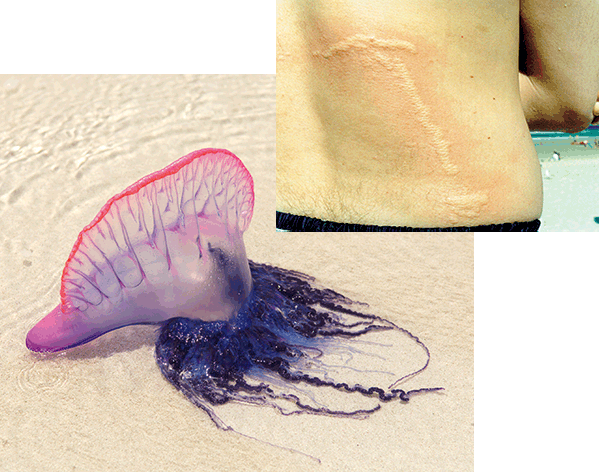The condition
Bluebottle stings
The bluebottle (Physalia spp.) – or Portuguese man o’ war – is not a true jellyfish, but a colony of individual organisms. Bluebottles are most common in non-tropical areas and may be seen washed up on beaches during high tide (Figure 1). There are around 10 000 cases of bluebottle stings on the east coast of Australia each year.

Figure 1. Bluebottle and (inset) appearance of bluebottle sting
A sting from a bluebottle causes an immediate sharp pain and acute inflammatory skin reaction, which has a linear appearance (Figure 1). The pain is worsened if the tentacles are moved or the area rubbed. The intense pain can last from minutes to many hours, and can be followed by a dull ache involving the joints.
The main symptom and management priority is usually pain.
Are there any key differentials to consider?
It is important to note that there are a range of marine creatures that can sting and cause envenomation. Geographic location may provide information and a likely cause. The Australian box jellyfish (Chironex fleckeri) and jellyfish causing Irukandji syndrome (carybdeids) are more common in tropical regions. Stings from these creatures can be potentially fatal, and require different first aid and management.
The intervention
What to do first
The person should leave the water immediately. If there is a significant sting to the face or neck, or if there are signs of severe illness (eg. breathing difficulties), an ambulance should be called by dialling 000.
Any tentacles that remain stuck to the skin should be removed, either by using tweezers or by hand (while wearing gloves). The site of the sting should then be washed with seawater.
How to provide the heat
Hot water immersion can be applied after initial treatment, but to be effective, heat needs to be applied as soon as possible after stinging.
Apply hot, but not scalding, water (ideally at 42–45°C), or a heat pack for 30–90 minutes or until the pain resolves. This can be done via:
- hot shower (which has the advantage of being able to vary the temperature)
- basin, bucket or bath filled with hot water
- heat packs.
As hot water may not be readily available at beach locations, consider self-heating heat packs for inclusion in first aid kits. Heat packs should have the capacity to reach a minimum 42°C.
Hot water (or heat) is proposed to work in one of two ways: via deactivation of heat labile proteins in the venom, and via modulation of pain receptors (the gate theory).
What should I consider?
Adverse effects
Heat treatment is safe if applied sensibly. The documented adverse effects are:
- common – some people are unable to tolerate the temperatures recommended
- infrequent – there is one recorded case of a thermal burn.
Evidence
National Health and Medical Research Council (NHMRC) Level 2 evidence (randomised controlled trial).
Anything else?
Although topical heat may be effective for Hawaiian box jellyfish, there are no studies suggesting it is effective for Australian box jellyfish (C. fleckeri), or for preventing Irukandji syndrome, which may follow stings by Carukia barnesi.
For bluebottle stings, do not apply alcohol and do not apply vinegar. While vinegar is appropriate for C. fleckeri stings, vinegar may cause bluebottle nematocysts to discharge.
Resources
Key references
- Atkinson PR, Boyle A, Hartin D, McAuley D. Is hot water immersion an effective treatment for marine envenomation? Emerg Med J 2006;23:503–8
- Loten C, Stokes B, Worsley D, Seymour JE, Jiang S, Isbister GK. A randomised controlled trial of hot water (45°C) immersion versus ice packs for pain relief in bluebottle stings. Med J Aust 2006;184:329–33
- Tibballs J. Australian venomous jellyfish, envenomation syndrome, toxins and therapy. Toxicon 2006;48:830–59
- Australian Resuscitation Council. Guideline 9.4.5: Envenomation – Jellyfish stings. 2010. Available at resus.org.au.
Patient resource
The New South Wales ambulance service has a bluebottle fact sheet. Available at www.ambulance.nsw.gov.au/ Media/docs/090730bluebottle-eee3bc83-ce7c-4281-a095-b427eb01e6d0-0.pdf.
Competing interests: None.
HANDI is supported by a grant from the Jack Brockhoff Foundation.
Provenance and peer review: Commissioned; not peer reviewed.